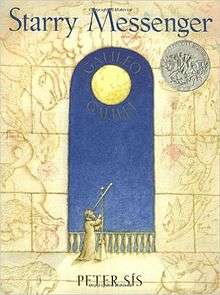Starry Messenger (picture book)
 First edition | |
| Author | Peter Sis |
|---|---|
| Cover artist | Peter Sis |
| Country | United States |
| Language | English |
| Subject | Biography |
| Published | Square Fish; Reprint edition (2000) |
| Pages | 40 p. |
Starry Messenger, about Galileo Galilei, is a children’s picture book written and illustrated by Peter Sis in 1996. It is a 1997 Caldecott Honor book. Through the use of his illustrations, Peter Sis documents different stages of life of the widely acknowledged scientist Galileo Galilei.
Plot
Starry Messenger written and illustrated by Peter Sis documents the life of the acclaimed scientist Galileo Galilei. Told from third person point of view and dating back to his birth, Sis walks the reader through the events that shape the life of the recognized scientist, mathematician, philosopher, and physicist, Galileo Galilei. The book opens with a prelude, with careful illustrations, Peter Sis sets the stage for the story by laying the groundwork of what the world was like during Galileo’s era; scientifically, and religiously. He introduces the reader to the then accepted ideology of the Ptolemaic System, which stated that the earth was the center of the solar system. Sis describes Galileo as a boy “born with stars in his eyes”, this metaphor will run throughout the length of the story connecting prominent events that occur within Galileo’s life, including life as a child, a scholar, and later a scientist. Inter sped with Sis’s original illustrations are excerpts of Galileo’s actual drawings and excerpts of his “Starry Messenger” which documents Galileo’s astronomical discoveries and observations especially the (Copernican theory which got him trouble with the Vatican Church. From being celebrated for his other astronomical discoveries to the controversial Copernican theory, Peter Sis documents these events with intricate illustrations that vividly resemble Galileo's own, adding depth to the story that critics have praised him for. The peak of the story occurs when Galileo's Copernican Theory reaches the Pope, and Galileo is viewed in negative light and criticism. Upon Galileo's summoning to the Vatican Church, he was forced to retract his earlier statements that contradicted with the ideologies of the Vatican Church regarding the placement of the Earth, or risk death. Galileo chose to retract his statements and was confined to house arrest for eight years before his death in 1642. The book ends on a positive note when Sis writes about the Pardon that was issued to Galileo more than three hundred years later in October 1992.
Critical Reception
Peter Sis’s documentation of the acclaimed scientist, Galileo Galileo’s life received positive reviews from: Kirkus Reviews, Booklist, School Library Journal and more. The New York Times had a section dedicated to the book praising Sis’s book, Elizabeth Spires writes, “The story of Galileo is not about a larger-than-life hero, but of someone understandably human.” She also writes, “in creating this original and exquisite book, affirms the power of one individual to change our ideas about the universe we live in.” The reviews commentate Pete Sis’s achievements in portraying Galileo’s life with “stellar illustrations” and interweaving some of Galileo’s original content from his acclaimed, Starry Messenger.
References
- Starry Messenger by Peter Sis , Peter Sis | Kirkus Reviews." Kirkus Reviews. 20 May 2010. Web. 14 Apr. 2016. <https://www.kirkusreviews.com/book-reviews/peter-sis/starry-messenger/>.
By, E. S. (1996, Nov 10).
- 'Stars were always on his mind'. New York Times (1923-Current File) Retrieved from http://search.proquest.com/docview/109564871
- Lukehart, Wendy, and Trevelyn E. Jones. "Preschool & Primary Grades: Nonfiction." School Library Journal 42.10 (1996): 118. MAS Ultra - School Edition. Web. 2 May 2016.
- Cooper, I. (1998). Starry Messenger. The Booklist, 95(7), 680. Retrieved from http://search.proquest.com/docview/235417064
- Jones, T. E., Toth, L., & Fleishhacker, J. (1996). Starry Messenger: Galileo Galilei. School Library Journal, 42(12), 32. Retrieved from http://search.proquest.com/docview/211685477
